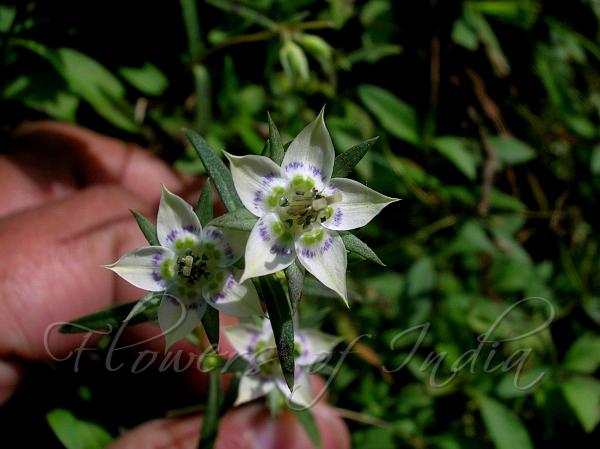|
| Panicled Swertia |
|

|

| File size | 435282 |
| Original date | 10/5/10 3:01 PM |
| Resolution | 2048 x 1536 |
| Flash | Flash did not fire, auto |
| Focal length | 8.0mm |
| Exposure time | 1/819s |
| Aperture | 5.5 |
| Focus Distance | |
| Metering Mode | Partial |
| Camera make | NIKON |
| Camera model | E3700 |
| Sensor type |
|
|
|
|
Photo: |
Botanical name: Swertia paniculata Family: Gentianaceae (Gentian family)
Synonyms: Ophelia paniculata, Ophelia wallichii, Swertia gracilescens
Synonyms: Ophelia paniculata, Ophelia wallichii, Swertia gracilescens
Panicled Swertia is an annual herb, growing up to 80-120 cm tall. Roots
are yellow and fibrous. Branched stems are slender, erect, 1.5-4 mm in
diameter. Basal leaves wither away at maturity. Stem leaves are nearly
stalkless, narrow lance-shaped, 2-5.5 cm long, 4-14 mm wide, margin
fringed with hairs. Inflorescences are panicles of cymes, many flowered,
spreading, to 70 cm. Flower stalks are erect, 0.6-1.5 cm long. Flowers are
5 parted, meaning with most parts occuring in fives. Sepal tube is 1-1.5
mm, with ovate-lance-shaped sepals, 6-10 × 2-5 mm. Flowers are pale yellow-
green, with 2 blackish purple spots above each nectary. Flower tube is
1-1.5 mm, with ovate petals, 6-8 mm long, with narrow tips. Nectaries are
1 per petal, horseshoe-shaped, naked. Stamens are 4-5 mm long, with purple
anthers. Capsules are ovoid, 8-10 mm. Flowering: August-October.
Medicinal uses: Decoction of the plant is used as tonic. Plant
is also used as substitute for Chirayita in
the treatment of malaria and other fever.
Decoction of the plant is used as tonic. Plant
is also used as substitute for Chirayita in
the treatment of malaria and other fever.
Medicinal uses:
 Decoction of the plant is used as tonic. Plant
is also used as substitute for Chirayita in
the treatment of malaria and other fever.
Decoction of the plant is used as tonic. Plant
is also used as substitute for Chirayita in
the treatment of malaria and other fever. | Identification credit: Navendu Pāgé | Photographed in Mussoorie, Uttarakhand. |
• Is this flower misidentified? If yes,